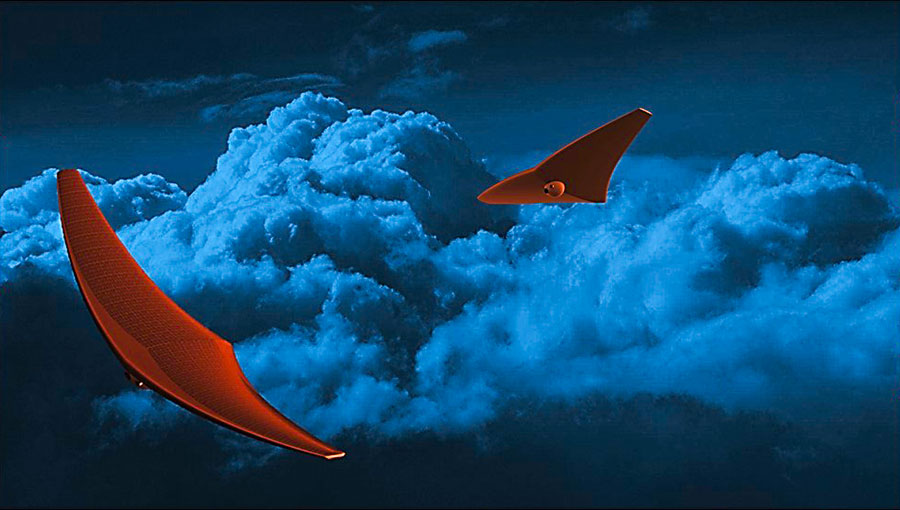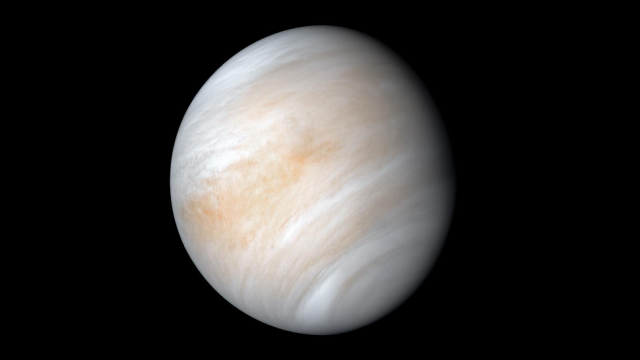Our minds were blown yesterday as a team of researchers reported on the discovery of phosphine in the atmosphere of Venus — a potential sign of life. The discovery will undoubtedly renew scientific interest in our closest planetary neighbour. Here’s what should happen next, and how scientists could confirm — or deny — the presence of life within the Venusian clouds.
Phosphine, a flammable gas typically associated with stinky swamps and penguin guano, is not something astrobiologists tend to focus on in their ongoing hunt for extraterrestrial life. That changed yesterday, owing to a new paper announcing the discovery of phosphine in the atmosphere of Venus.
On Earth, this gas — a lone phosphorus atom accompanied by three hydrogen atoms — is primarily produced by microorganisms capable of thriving in oxygen-deprived environments. The discovery of phosphine on Venus at around 20 parts per billion comes as a complete surprise, given that life isn’t supposed to exist on this allegedly inhospitable planet and because this gas should be annihilated by both ultraviolet radiation and by the tremendous amount of sulphuric acid in the Venusian clouds. Something, it would appear, is producing phosphine on Venus. But what?
[referenced id=”1443024″ url=”https://gizmodo.com.au/2020/09/scientists-detect-apparent-signature-of-life-in-venuss-atmosphere/” thumb=”https://gizmodo.com.au/wp-content/uploads/2020/09/15/oncm6vlydgqgfy10tmqz-300×169.jpg” title=”Scientists Detect Apparent Signature of Life in Venus’s Atmosphere” excerpt=”In a major announcement, a team of scientists is claiming to have detected trace amounts of phosphine in the atmosphere of Venus. It’s a bizarre and potentially monumental finding, as living organisms are the only known source of this stinky, toxic gas.”]
The authors of the new study, led by astronomer Jane Greaves from Cardiff University, were restrained in their analysis, saying the new research is not evidence of life on Venus. But they did say, however, that the phosphine is likely being produced by some unknown chemical process or by life itself.
Venus hadn’t been much of a target for astrobiologists, as the planet’s surface cooks at around 450 degrees Celsius and its air exerts 90 times the pressure that we experience on Earth. If life actually exists on Venus — and that’s still a big if — it will force a serious re-thinking of planetary habitability, both in our solar system and beyond.
Venus, for reasons that are completely understandable, is very poorly understood, despite it being the closest planet to Earth. Historically, it has been deemed an unappealing target for expensive scientific missions, with other planets, namely Mars, getting much of the attention.
“Over the past two decades, we’ve made new discoveries that collectively imply a significant increase of the likelihood to find life elsewhere,” explained a NASA spokesperson in an emailed statement. “As with an increasing number of planetary bodies, Venus is proving to be an exciting place of discovery, though it had not been a significant part of the search for life because of its extreme temperatures, atmospheric composition, and other factors.”
Accordingly, scientists have an incomplete understanding of Venus’s surface topography, geology (including its geological history), tectonics, and potential volcanism. The discovery of phosphine on Venus, however, is the “most significant development yet in building the case for life off Earth,” said NASA administrator Jim Bridenstine in a tweet put out yesterday, to which he added: “It’s time to prioritise Venus.”
Life on Venus? The discovery of phosphine, a byproduct of anaerobic biology, is the most significant development yet in building the case for life off Earth. About 10 years ago NASA discovered microbial life at 120,000ft in Earth’s upper atmosphere. It’s time to prioritize Venus. https://t.co/hm8TOEQ9es
— Jim Bridenstine (@JimBridenstine) September 14, 2020
Indeed, the time is nigh to science the shit out of Venus. Before we start sending probes to investigate, however, there’s still work to do right here on Earth. First and foremost, scientists will need to confirm the phosphine wavelength signal that Greaves and her colleagues collected with the James Clerk Maxwell Telescope in Hawai’i and the Atacama Large Millimetre Array in Chile.
“The first priority should be to confirm the detection by searching for phosphine at other wavelengths while also trying to map the global distribution of phosphine,” Sanjay Limaye, a scientist at the University of Wisconsin-Madison, explained in an email. “This will not be easy, due to the relatively small abundance at ultraviolet and infrared wavelengths, as the spectral signature of phosphine may be masked by signatures of more abundant chemicals such as carbon dioxide, water vapour, sulfuric acid, and so on.”
Venus, as an inner planet, is never too far from the Sun in the sky, making observations difficult at certain wavelengths, said Limaye. Thankfully, radio observations don’t have this problem, he noted. In addition to searching for biospecific gases, he said scientists should look for discernible contrast features in Venus’s atmosphere and try to track the evolution and chemical properties of these features.
Two years ago, Limaye led a study arguing that contrast features in the form of dark splotches could be a sign of life on Venus and that the Venusian atmosphere might be capable of harbouring microorganisms. It seemed like a kooky idea at the time. Today, not so kooky.
Eventually, we’ll want to send probes to Venus. The good news, as NASA explained in the emailed statement, is that two of the next four candidate missions for NASA’s Discovery Program — VERITAS and DAVINCI+ — are focused on Venus, as is the European Space Agency’s EnVision mission, of which NASA is a partner. Venus, due to its close proximity, could also be explored with more modest missions.
DAVINCI+, which stands for Deep Atmosphere Venus Investigation of Noble gases, Chemistry, and Imaging Plus, is a probe that would slowly descend down to the Venusian surface with a parachute. With its suite of onboard instruments, the probe will sniff out various gases and map the surface. VERITAS, an acronym for Venus Emissivity, Radio Science, InSAR, Topography, and Spectroscopy, would involve a satellite in orbit around Venus. In addition to creating a 3D topographical map of the planet, the probe would take Venus’s temperature, study its gravitational field, perform some remote geology, and deploy a probe equipped with a mass spectrometer for detecting chemical signatures. EnVision is a satellite that would primarily study the planet’s geology, but this probe could be leveraged for many other tasks given its impressive array of sensors.
There’s also the private sector to consider, namely a mission to Venus proposed by Rocket Lab founder and millionaire Peter Beck (you may remember his shimmering “Humanity Star” — a disco ball-like object launched into orbit in 2018). Under Beck’s plan, a probe equipped with several instruments would be sent into Venus’s atmosphere. During a press conference held yesterday, Greaves said her team is open to working with the private sector.
To be clear, none of these missions have been approved, but Venus got considerably sexier overnight.
Once these or other probes are deployed, scientists should sample the cloud layer, which extends from around 47 to 70 km above the surface. Limaye described these surveys as “essential.” By taking measurements in the clouds, scientists “should be able to find any presence of not only phosphine but also other biologically significant gases such as methane,” he explained. Another useful task would be to determine the “physical, chemical and biological properties of the cloud droplets within which microorganisms can live,” he said, assuming of course that microbes do exist on Venus.
A semi-buoyant platform, like Northrop Grumman’s VAMP, would be ideal for this task, said Limaye, as it could be equipped with microscopes, spectrometers, and other instruments.
Another possibility are balloons akin to the Soviet Vega missions of the mid-1980s. This is the “kind of thing we’d like to see happen again,” said Sara Seager, an astrobiologist from MIT and a co-author of the new study, at a press conference held yesterday. “Perhaps a super version of those [Vega balloons] that, instead of lasting a couple of days, could last a week, months, even a couple of years,” she said. Seager described balloons as “certainly the best way” to study the Venusian atmosphere, for the same reasons highlighted by Limaye (though to be fair, balloons would be far less manoeuvrable than VAMP or similar aerial vehicles, like those proposed stingray-shaped gliders called BREEZE).

Linaye and Seager both said that onboard spectrometers would be critical to such a mission.
“From spectrometers operating at different wavelengths from UV to millimetre, it should be possible to map distributions of phosphine, sulphur dioxide, and other gases to see if they are correlated with the cloud cover contrast features seen in the Venus images,” explained Linaye.
This could inform scientists to a connection between possible life forms and the contrast features, as Linaye and his colleagues suggested in their 2018 paper. Other important instruments for an atmospheric probe would include meteorological sensors for collecting environmental data, chemical sensors for studying the planet’s atmospheric composition, a fluorescence imaging microscope for making physical and biological characterizations, and other sensors that can detect biosignatures, he said. For Venusian orbiters, Linaye recommended multispectral imaging cameras and, you guessed it, spectrometers.
In addition to these projects, scientists need to figure out what kind of funky abiotic or biotic chemistry could possibly be going on in the Venusian atmosphere. Phosphine is naturally produced through non-biological process on Saturn and Jupiter, but similar conditions aren’t found on Venus. Maybe there’s something scientists aren’t considering, as the new study suggested. Computer algorithms capable of mixing and matching combinations of atoms might help.
Meanwhile, biologists should figure out how extremophile microbes might be capable of withstanding the harsh conditions found in Venus’s atmosphere. As Greaves explained at the press conference, the “real challenge is seeing whether any form of life could evolve to adapt to the incredibly acidic environment,” as there is nothing analogous to this on Earth. Simply put, this proposed form of life might actually be evolutionarily or biologically impossible.
Indeed, it’s time for scientists to get multidisciplinary, as this effort will require astronomers, engineers, astrobiologists, microbiologists, chemists, geologists, computer scientists, and planetary scientists, among other specialists (like, what are the ethical and safety concerns of studying these microbes, should they exist? What if, in our rush to find life, we accidentally contaminate Venus with our Earthly germs?). And of course, all incoming data will have to be scrutinised, confirmed, and replicated for scientists to make definitive conclusions.
No one said it was going to be quick or easy to find extraterrestrial life, but with microscopic aliens potentially lingering at our doorstep, it’s time to seriously up our game.
